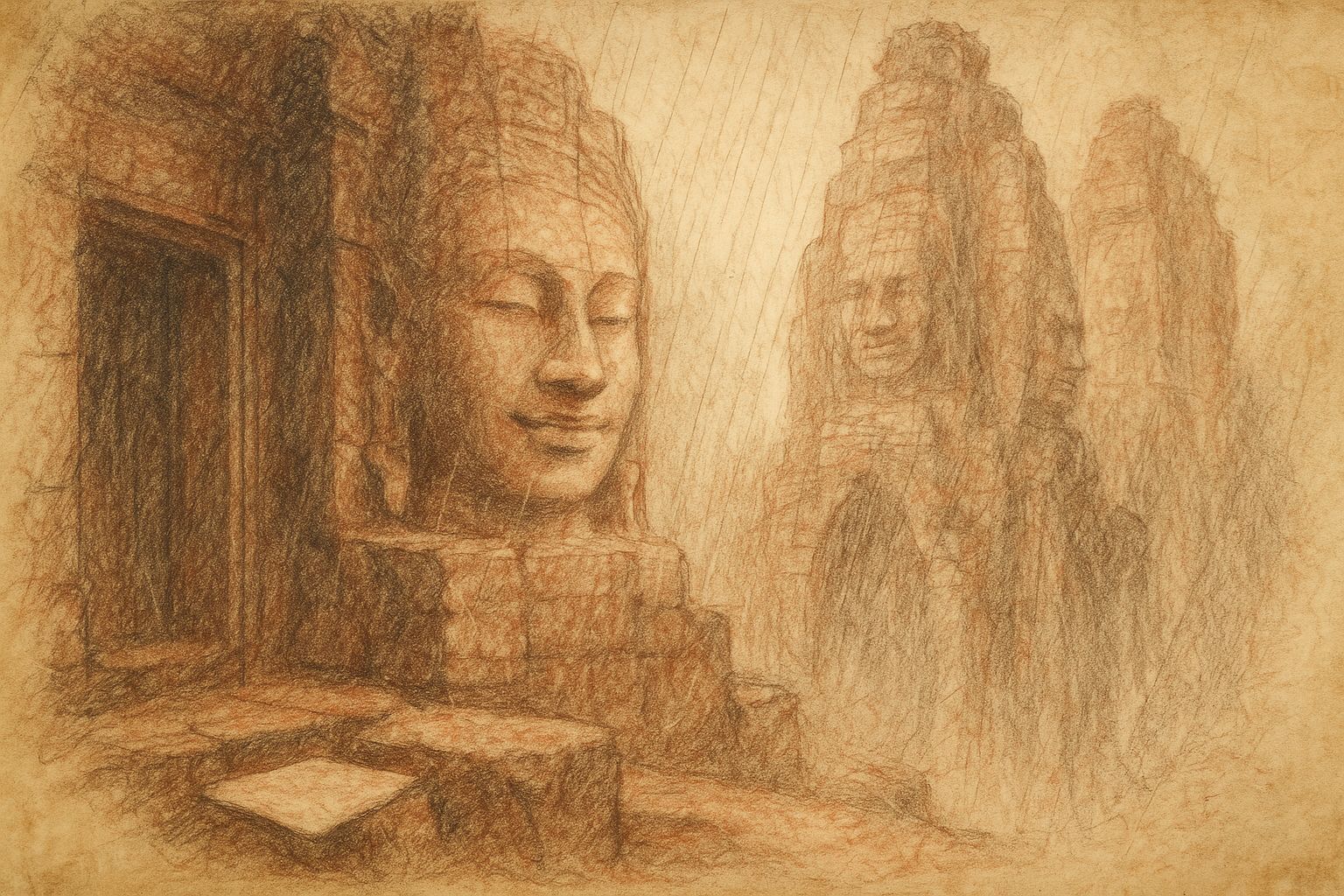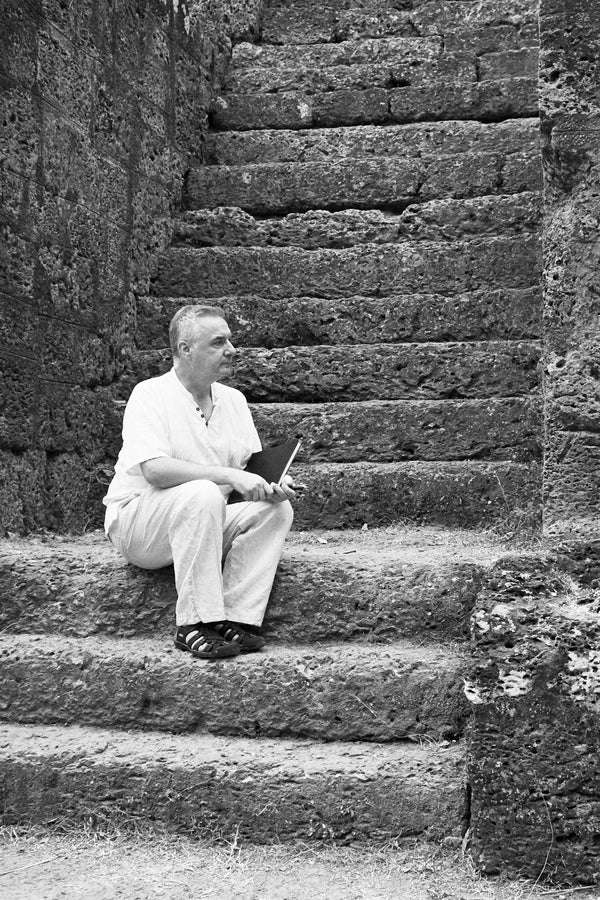Complimentary worldwide shipping on orders over $400 · No import tariffs for most countries
Complimentary worldwide shipping on orders over $400 · No import tariffs for most countries

The Bayon: Faces at the Threshold of Silence
3 min read
Rain beads on a carved lip.
A tower’s face listens inward.
My hand finds the cold step.
Silence gathers in wet stone.Yet the smile holds.
Dynasties turn beneath moss.
Erased names breathe in damp inscription.
I leave the threshold carrying rain—
a quiet weight of stone.
Rain lingers in the crevices of the Bayon. Each drop gathers on the lips of a face, slides down the cheek of stone, and falls into silence. Standing before this temple, one does not begin with its crowded galleries or its complex plan. One begins at the threshold—the pause before entry, when the carved gaze of towers looks back, and you are already inside without having crossed.
The Bayon belongs to no single time. It began in the reign of Jayavarman VII, when Angkor was both wounded and remade. His enemies had pressed fire into the royal palace; his body carried scars of swords. He answered with walls, moats, and sanctuaries—his capital Angkor Thom enclosed, his state temple raised at its centre like a lotus in dark water. The Bayon’s plan was never still: cruciform at first, then expanded, altered, re-faced across reigns, across beliefs. Its faces endure not as portraits of kings but as thresholds of presence, witnesses carved where silence itself required form.
—
Thresholds are always double. To step into the Bayon is to step into a city of transformations. Jayavarman VII consecrated it to the Buddha; Indravarman II may have added the face-towers, smiling enigmas still unclaimed by certainty. Jayavarman VIII, a Hindu, shattered Buddhas and replaced the central image with Harihara, half Vishnu, half Śiva. Faiths turned, walls were rebuilt, chapels erased. Yet the towers, lifted above galleries like thoughts rising from meditation, watched through it all. Their gaze dissolves division: Buddhist, Hindu, royal, human—each is absorbed into the stone’s breath.
At the eastern entrance, the first step is the moment of surrender. The visitor feels the uneven stone beneath the foot, traces the softened carving with a hand. This embodied witness—the contact of body and monument—becomes the hinge of understanding. The Bayon is not a puzzle to be solved but a threshold to be crossed. Its inscriptions, few and scattered, whisper names of divinities once enthroned in sanctuaries: Lokesvara, Visnu, Śiva, ancestral kings. Each god resides as if in dialogue with the others, grouped not in separate temples but drawn inward to the centre.
—
A sketchbook rests against my knee. Lines in chalk blur where the rain has fallen. I try to follow the curve of a nose, the swell of a lip, but the face slips away into weather. Each attempt reminds me that the Bayon itself is a sketch—layer upon layer of revision, towers added, galleries walled, chapels demolished, Buddha faces recut into ascetics. It is unfinished by design, or perhaps finished in its very incompletion. What endures is not the precision of its form but the rhythm of alteration, the memory that stone carries even when inscriptions are erased.
The faces, multiplied and watching, are the Bayon’s parable. They are not simply likenesses of kings or deities. They are thresholds carved into stone—faces that look outward and inward at once. They teach that sovereignty is fragile, that devotion is mutable, that even temples must learn impermanence. Their presence unsettles because it is tender: the slight smile that lingers across centuries is a gentleness that shocks, unsettling because it has survived ruin.
—
History tells us the Bayon was not a solitary act of genius but the result of successive reigns, conflicts, and erasures. Yet to stand within its galleries is to feel no fracture, only an atmosphere of continuity—stone carrying memory across centuries. The bas-reliefs, vivid with battles, markets, festivals, and naval scenes, bring Angkor’s pulse into visibility. Soldiers clash, fishers cast nets, dancers raise arms in rhythm. These reliefs remind us that temples are not only for gods but for communities whose footsteps polished the thresholds, whose offerings still scent the chambers with a faint trace of smoke.
The Bayon is therefore less a monument than a living argument: between religions, between kings, between permanence and erosion. Its towers bear faces that outlasted dogma, reminding us that the spirit of place cannot be erased even by chisels driven with zeal.
—
At the close, I return to where I began: the threshold. Rain gathers again on the lips of stone. My hand rests on a fallen block, cool and rough, its carving half erased. It is a fragment, but it carries the whole: the silence of memory, the trace of devotion, the breath of impermanence.
The Bayon teaches through its incompletion. To cross its threshold is to step into a silence that remembers. To leave is to carry that silence outward, as if the faces themselves had leaned closer to whisper: nothing endures but presence, and even presence is carved from passing rain.
The Gaze Beyond Time
Photographs from Bayon Temple – Spirit of Angkor series by Lucas Varro
At the quiet heart of Angkor Thom stands Bayon—a temple not of distance, but of presence. Here, within a sanctuary of face towers and shadowed corridors, stone watches stone, and silence looks back with a gaze as serene as it is infinite.
These monumental visages—half-smiling, half-sleeping—rise above the treetops like contemplative sentinels, their features weathered by rain, light, and centuries of unseen prayer. At Bayon, the sacred is not hidden; it is met in every direction, every turning, every pause. This is a temple of interior vastness—less a monument than a mirror to the soul.
In this collection from the Spirit of Angkor series, Lucas Varro draws near to these enigmatic faces and the subtle mysteries they hold. Using large and medium format black-and-white film, each image is shaped through long exposure and chiaroscuro, then hand-toned by the artist to reveal not only the architecture—but the atmosphere within it. Stillness shaped by shadow. Compassion carved in light.
Offered as limited edition prints on museum-grade Hahnemühle Bamboo paper, each photograph is accompanied by a Collector’s Print Package containing poetic writings, curatorial notes, and reflections drawn from the artist’s field journals.
This is Bayon not as history—but as presence. A sanctuary of stone that sees you, even now.
Join My Studio Journal
Receive occasional letters from my studio in Siem Reap—offering a glimpse into my creative process, early access to new fine art prints, field notes from the temples of Angkor, exhibition announcements, and reflections on beauty, impermanence, and the spirit of place.
No noise. No clutter. Just quiet inspiration, delivered gently.
Subscribe and stay connected to the unfolding story.

Join My Studio Journal
Receive occasional letters from my studio in Siem Reap—offering a glimpse into my creative process, early access to new fine art prints, field notes from the temples of Angkor, exhibition announcements, and reflections on beauty, impermanence, and the spirit of place.
No noise. No clutter. Just quiet inspiration, delivered gently.
Subscribe and stay connected to the unfolding story.




